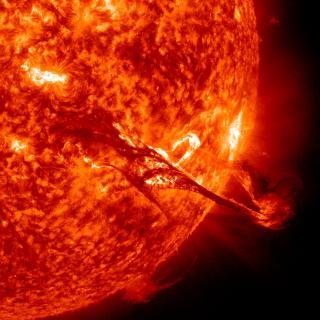Bibcode
Baweja, Upasna; Pant, Vaibhav; Arregui, Iñigo
Bibliographical reference
The Astrophysical Journal
Advertised on:
3
2024
Journal
Citations
2
Refereed citations
2
Description
Estimating the magnetic field strength in the solar corona is crucial for understanding different physical processes happening over diverse spatiotemporal scales. However, the high temperatures and low density of the solar corona make this task challenging. The coronal magnetic field is too weak to produce a measurable splitting of the spectral lines using the Zeeman effect, and high temperature causes spectral lines to become weak and broad, making it difficult to detect the small Zeeman splitting. Coronal magneto-seismology, which combines the theoretical and observed properties of magnetohydrodynamic waves, can be used to infer the magnetic field strength of oscillating structures in the solar corona, which are otherwise difficult to estimate. In this work, we use the Doppler velocity and density data obtained from the Coronal Multichannel Polarimeter on 2016 October 14 to obtain the global map of the coronal magnetic field using Bayesian inference. Two priors are used for plasma density, viz Gaussian and uniform distributions. Bayesian inference provides us with the probability distribution for the magnetic field strength at each location from 1.05 to 1.35 R ⊙. A comparison between the magnetic field obtained using simple inversion and Bayesian inference is also drawn. We find that the values obtained using simple inversion do not always match the maximum posterior estimates obtained using Bayesian inference. We find that the inferred values follow a power-law function for the radial variation of the coronal magnetic field, with the power-law indices for simple and Bayesian inversion being similar.
Related projects

Solar and Stellar Magnetism
Magnetic fields are at the base of star formation and stellar structure and evolution. When stars are born, magnetic fields brake the rotation during the collapse of the mollecular cloud. In the end of the life of a star, magnetic fields can play a key role in the form of the strong winds that lead to the last stages of stellar evolution. During
Tobías
Felipe García

Numerical Simulation of Astrophysical Processes
Numerical simulation through complex computer codes has been a fundamental tool in physics and technology research for decades. The rapid growth of computing capabilities, coupled with significant advances in numerical mathematics, has made this branch of research accessible to medium-sized research centers, bridging the gap between theoretical and
Daniel Elías
Nóbrega Siverio